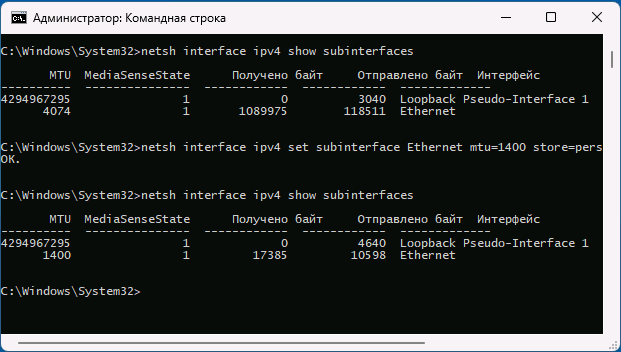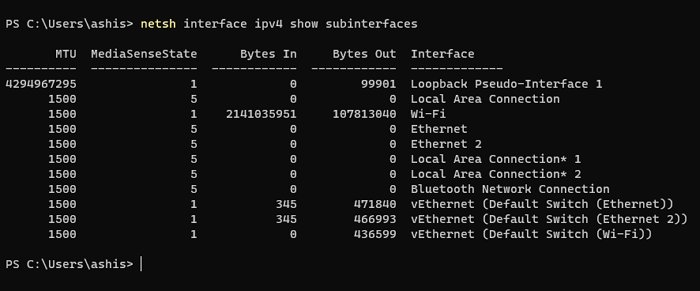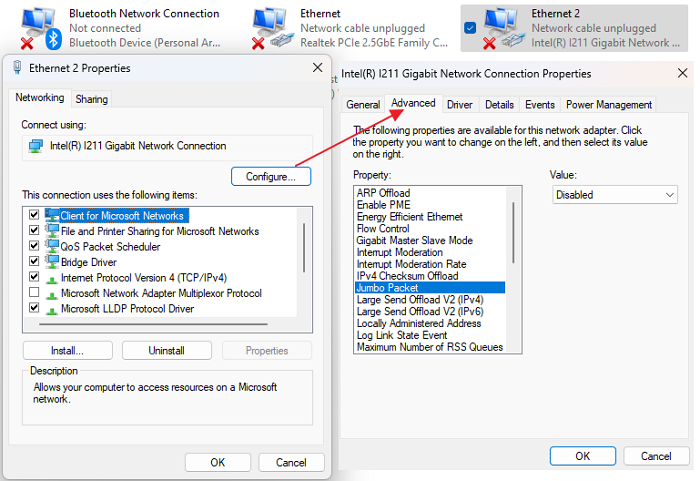Настройка MTU (Maximum Transmission Unit) знакома большинству пользователей, которые когда-либо настраивали Wi-Fi роутеры, но доступна и в Windows для Ethernet и других подключений. MTU — это максимальный размера блока данных одного пакета в байтах (без учета размера заголовка), стандартный размер — 1500 байт.
При необходимости размер MTU в Windows 11, 10 и других версий можно изменить. В этой инструкции — о том, как это сделать, а также узнать текущий размер MTU.
Способы изменения размера MTU в Windows 11 и Windows 10
Прежде чем приступить, вы можете определить текущий размер MTU для сетевых интерфейсов, для этого достаточно запустить командную строку или Терминал от имени администратора, после чего использовать следующую команду:
netsh interface ipv4 show subinterfaces

Размеры MTU будут указаны в первом столбце в результатах выполнения команды. Если вам требуется изменить размер пакета, вы можете использовать один из следующих способов.
Включение Jumbo frame
Первая возможность — включить Jumbo Frame (Jumbo-кадр), позволяющий передавать данные в размере, превышающем стандартные 1500 байт. Для этого используйте следующие шаги:
- Нажмите клавиши Win+R, введите ncpa.cpl и нажмите Enter.
- В списке подключений нажмите правой кнопкой мыши по подключению, для которого нужно включить Jumbo frame и выберите пункт «Свойства».
- Нажмите кнопку «Настроить» для настройки сетевого адаптера.
- На вкладке «Дополнительно» найдите пункт «Jumbo packet» и измените его значение, затем примените настройки.
При включении Jumbo frame соединение может быть кратковременно разорвано, но обычно затем работает исправно. Учитывайте, что настройка Jumbo packet может быть доступна не для всех сетевых карт, также её наличие может зависеть от используемых драйверов.
Изменение MTU в командной строке
Вторая возможность — использование командной строки для изменения размера MTU:
- Запустите командную строку от имени администратора и введите следующую команду, чтобы посмотреть список имен интерфейсов:
netsh interface ipv4 show subinterfaces
- В следующей команде измените ИМЯ_ИНТЕРФЕЙСА и значение MTU для изменения MTU для соответствующего подключения:
netsh interface ipv4 set subinterface ИМЯ_ИНТЕРФЕЙСА mtu=РАЗМЕР store=persistent
После успешного выполнения команды, размер MTU будет изменен.
Определить оптимальный размер пакета (значение MTU) для текущего Интернет-подключения можно в командной строке с помощью команды, ping адреса_сайта -f -l РАЗМЕР, например:
ping google.com -f -l 1500

Задачей будет поиск такого значения MTU, которое не приводит к сообщениям о необходимости фрагментации пакета.
Sometimes, you may have noticed that some websites don’t function well on your broadband connection. While most websites run fine, certain seem to have an issue. If you have encountered this situation, it is time to change the Maximum Transmission Unit (MTU) on Windows 11/10 computers.
How to check current MTU settings?
MTU, or Maximum Transmission Unit, is necessary or responsible for this case because it is the parameter that defines the maximum packet size that can be transmitted over a network. So by optimizing MTU, you can enhance your network performance. As a result, you can browse the internet more efficiently.
But not many are aware of how MTU functions. There are two quick ways to check the current MTU settings, these are:
Use Windows Terminal to check the current MTU value
Windows Terminal has to be the easiest way to learn about your current MTU value. To get started, follow the below steps:
- Press Windows Key + X to access the quick menu.
- Click Windows Terminal (Admin).
- Now run the following command and press enter.
netsh interface ipv4 show subinterfaces
- Once done, you should see the MTU value of different networks under the MTU tab.
Check MTU network adapter settings
There is also an alternative option which is checking through the Network adapter settings. For this, you need to follow the below steps:
- Press the Windows key + R to launch Run.
- Type ncpa.cpl and press Enter, and you should see a list of different Network adapters.
- Right-click on any of the adapters for which you want to check the MTU and then select Properties.
- Click the Configure button to open the adaptor connection properties
- Switch to the Advanced Tab and select Jumbo Frame
- Then select the higher value from the dropdown on the right.
Note: The adapter uses the default MTU value if you don’t see the Jumbo Packet option. It also means you cannot change through the control panel method.
Now that you know your MTU value, you can increase or decrease the value per your needs. To do so, there are two methods that you can follow. These are:
- Using Windows Terminal
- Changing MTU through Network Adapter settings
Let’s now look at these methods one by one below:
1] Using Windows Terminal
Changing MTU using the command prompt has to be the easiest method. All you have to do is run two commands – one to identify the interface name and the other to change the MTU value, and you are good to go. So go ahead and follow these steps:
- First, press Windows Key + X to access the quick menu and launch Windows Terminal (Admin).
- Now run the following command to list down all the network adapters:
netsh interface ipv4 show subinterfaces
- Now note down the Interface name for which you want to change the MTU.
- Next, to change the MTU value of your preferred interface, run the following command:
netsh interface ipv4 set subinterface <subinterface name> mtu=9000 store=persistent
- Over here, replace <subinterface name> with the interface name. Also, you change the mtu=9000 value to something else per your requirements.
2] Changing MTU through network adapter settings
You can do it through Network Adapter settings to change your MTU value through a visual interface. For this, follow the below steps:
- Launch Run by pressing Windows Key + X.
- Type ncpa.cpl and press Enter.
- Right-click on your preferred Network adapter and go to Properties.
- Next, click on the Configure button.
- Next, select Jumbo Packet, and from the disable dropdown menu, select any of the MTU values.
- Once done, save the changes and reboot your computer.
How to determine the optimal MTU Value?
Now you might be wondering what would be the ideal MTU value. You can quickly figure that out by running a command in Windows Terminal.
You need to run the ping command, which will send requests to the network and increase the size of the Packet till you get a message about the needed fragment of the Packet. So whichever website is not loading correctly, you can try the ping command with it by following the below steps:
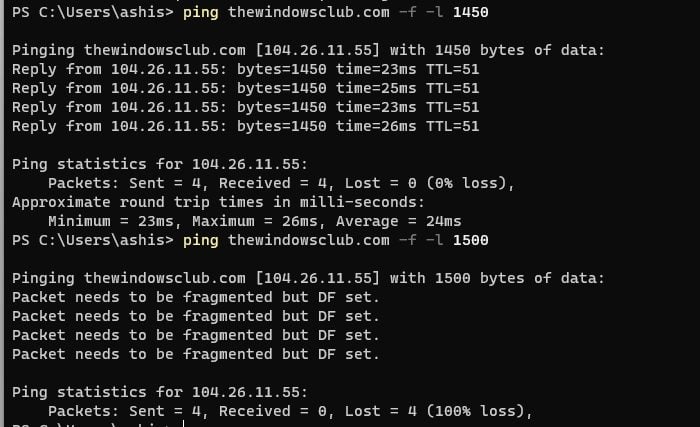
Launch Windows Terminal, and run the following command:
ping [url] -f -l <packet_size>
Over here, replace [url] with your respective URL and set the <packed_size> to 1450. As you run your ping, keep increasing the size with each command until you see the Packet needs to be the fragmented message.
How to troubleshoot Common Issues around MTU?
While dealing with MTU, it is easy to mess things up. If you enter the wrong MTU value, it can impact the overall network performance.
In such a case, you can try restoring the default MTU value. The default MTU value on most computers is 1500. So you can follow the above steps to change the MTU value to 1500 and see if it helps you out.
If you still face any other internet issues, running Windows Troubleshooter might be helpful. To run it, follow the below steps:
- Press Windows Key + I to launch Settings.
- Navigate to System > Troubleshoot > Other troubleshooters.
- Over here, click on the Run button next to Internet Connections and let the troubleshooter run.
Conclusion
So that was all for how to change MTU on Windows 11/10. Changing MTU value using Windows Terminal is a much easier and straightforward process. While if you make the changes using Network adapters, you may not find the required options to make changes. So go ahead and try the above steps on your own and see if they are helpful to you.
Changing the Maximum Transmission Unit (MTU) on your Windows 10 computer can help improve network performance, especially if you’re experiencing connectivity issues. It’s a quick and straightforward process that involves using the Command Prompt to adjust the network settings.
Changing the MTU on Windows 10 can optimize how data packets are transmitted over the network, potentially reducing latency and fragmentation. Follow these steps to adjust your MTU settings.
Step 1: Open Command Prompt as Administrator
Begin by opening the Command Prompt with administrative privileges.
Right-click the Start menu and select «Command Prompt (Admin)» or «Windows PowerShell (Admin).»
Step 2: Find the Network Interface
You need to identify the network interface you wish to change.
Type netsh interface ipv4 show subinterfaces and press Enter. This command will display a list of network interfaces and their current MTU settings.
Step 3: Set the New MTU Value
Now, set the MTU value to your desired number.
Type netsh interface ipv4 set subinterface "Local Area Connection" mtu=XXXX store=persistent and press Enter. Replace «Local Area Connection» with the name of your network interface and «XXXX» with the MTU value you want to set.
Step 4: Confirm the Change
Double-check to make sure the change was successful.
Type netsh interface ipv4 show subinterfaces again and press Enter. Verify that the MTU value has been updated.
Step 5: Restart Your Computer
Finally, restart your computer to ensure the settings take effect.
After a reboot, your new MTU settings should be active. This step helps to solidify the changes made to your network configuration.
Once you have completed these steps, your network interface will operate with the new MTU value, which can lead to improved network performance and fewer connectivity issues.
Tips for Changing MTU on Windows 10
- Test different MTU values to find the optimal setting for your network.
- Always use the Command Prompt as an administrator to ensure you have the necessary permissions.
- Note down your original MTU settings before making any changes, so you can revert back if needed.
- If you experience issues after changing the MTU, try lowering the value incrementally.
- Use online tools or ping tests to determine the correct MTU value for your specific network.
Frequently Asked Questions
What is MTU?
MTU stands for Maximum Transmission Unit, and it determines the largest size of a data packet that can be sent over a network.
Why change the MTU?
Changing the MTU can help optimize network performance, reduce packet fragmentation, and resolve connectivity issues.
What is a typical MTU value?
The standard MTU value for Ethernet networks is usually 1500 bytes, but it can vary depending on the network.
How do I find the right MTU value?
You can use ping tests with the «don’t fragment» flag to discover the optimal MTU value for your network.
Can changing the MTU harm my computer?
Generally, no. However, setting an incorrect MTU value might cause connectivity issues. Always note down original settings before making changes.
Summary
- Open Command Prompt as Administrator.
- Find the Network Interface.
- Set the New MTU Value.
- Confirm the Change.
- Restart Your Computer.
Conclusion
By following these steps, you can change the MTU on Windows 10 and potentially improve your network performance. Whether you’re dealing with slow internet speeds, frequent disconnections, or other network-related issues, adjusting the MTU can make a notable difference. Always remember to note down your original settings, so you can easily revert back if needed.
Understanding your network settings is key to maintaining an efficient and fast internet experience. If you’re interested in learning more about network optimization, there are numerous resources available online to deepen your knowledge.
In the meantime, go ahead and give it a try. Sometimes a small tweak like adjusting the MTU can have a big impact on your day-to-day internet usage.
Matt Jacobs has been working as an IT consultant for small businesses since receiving his Master’s degree in 2003. While he still does some consulting work, his primary focus now is on creating technology support content for SupportYourTech.com.
His work can be found on many websites and focuses on topics such as Microsoft Office, Apple devices, Android devices, Photoshop, and more.
Sometimes, you may find that you have issues with network performance or bandwidth utilization, which may be related to the MTU settings. If that affects your efficiency, you can consider changing MTU on your computer. This post in MiniTool will teach you how to change MTU in several ways.
MTU (Maximum Transmission Unit) is a necessary parameter which defines the maximum size of a packet that can be transmitted over a network. Therefore, by changing the MTU, you can enhance your network performance. In this way, you can browse the website more efficiently and smoothly.
Larger MTU are associated with reduced overhead. Smaller MTU values can reduce network latency. In many cases, the MTU depends on the underlying network capabilities and must be adjusted manually or automatically to avoid exceeding those capabilities. The MTU parameter may be associated with a communications interface or standard. Some systems may determine the MTU at connection time, such as using path MTU discovery.
How to Access MTU Settings on Windows
Before you change MTU, you need to access it to check its value and the network adapter settings. Here’s how to access MTU settings.
Access MTU value.
Firstly, you should click on the Search icon in the taskbar. Type Terminal in the box. If it appears in the search list, right-click on it and choose Run as administrator to open it. If there is nothing about it, probably you don’t install it. You can go to the Microsoft Store to download and install Windows Terminal. When finished, repeat the operations.
Secondly, type this command: netsh interface ipv4 show subinterfaces and press Enter to run it.
Lastly, wait for the process to complete, and you can see the MTU value of different networks under the MTU tab.
There is also an alternative option, which is to check the MTU value through the network adapter settings. To get started, you need to follow the below instructions:
Access MTU network adapter settings
Firstly, you need to press the Win + R keys to launch the Run window. Type ncpa.cpl in the Open box and press Enter, and you can see a list of different network adapters.
Secondly, right-click on any adapters of which you want to check the MTU and then choose Properties.
Lastly, click the Configure… button to open the adaptor connection properties. Switch to the Advanced tab and select Jumbo Frame under Property. Then you can see the value from the Value list on the right. Then click OK to close the window.
If the MTU value is not proper, the network may function slowly. Here are two ways for you to change the MTU value.
Method 1: Changing MTU With Windows Terminal
Not only can you use Windows Terminal to check the MTU value, you can also use it to change the value. Here are the steps to change it.
Step 1: Press the Win + S keys to open the Search window.
Step 2: Input Terminal in the box, right-click on it, and choose Run as administrator.
Step 3: When prompted by UAC, click on Yes to continue.
Step 4: Type this command: netsh interface ipv4 show subinterfaces and press Enter.
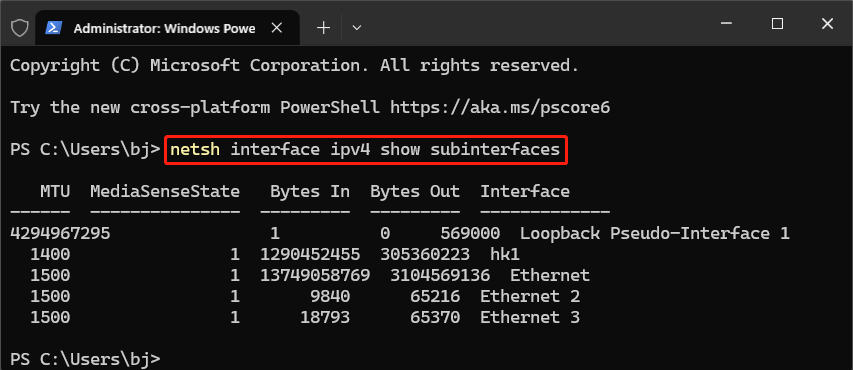
Step 5: Until the previous step is finished, continue to type this command: netsh interface ipv4 set subinterface <subinterface name> mtu=9000 store=persistent and press Enter.
Tips:
Remember to replace the subinterface name with the interface name you want to change.
Once you have done these steps, close the window and restart your computer.
Method 2: Changing MTU From Network Adapter Settings
Using Network Adapter Settings to change MTU value is also a good option. Some operations are as follows.
Step 1: Right-click on the Start button and choose Settings.
Step 2: In Settings, select the Network & Internet option, and then click on Ethernet.
Step 3: In the right pane, click on Change adaptors options under the Related settings option.
Step 4: Right-click on any adapter you want to change and choose Properties.
Step 5: In the Ethernet Properties window, click on the Configure… button.
Step 6: On the new page, switch to the Advanced tab, and select Jumbo Frame under Property.
Step 7: Expand the Value drop-down triangle to choose the MTU value you want and click on OK to close the window.
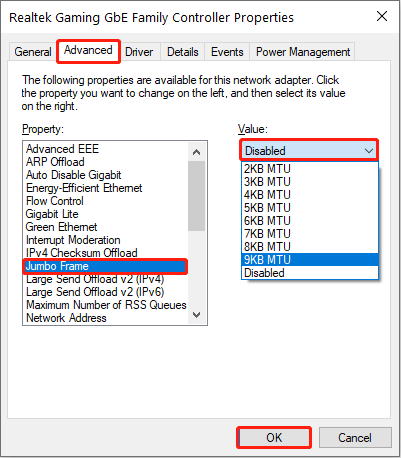
After finishing these instructions, reboot your computer to save these changes.
Tips:
If your network is still slow, you can use MiniTool System Booster to fix it. It not only optimizes hidden Windows Internet settings but also has a variety of built-in features that can help free up more system resources, thereby improving network speed and computer performance.
MiniTool System Booster TrialClick to Download100%Clean & Safe
Final Words
So that was all for how to change MTU on Windows. Believe you have a better understanding of MTU settings. If you are in such a need, you can refer to one of the ways above according to your preferences to perform an MTU settings change.
Changing the MTU Size in Windows 11
Need to tweak your internet settings for better performance? Changing the MTU (Maximum Transmission Unit) size can help. It involves a few simple steps using Command Prompt. Here’s how to do it in a nutshell: open Command Prompt as an administrator, find the current network interface, and use a specific command to modify the MTU size.
Changing the MTU size can help optimize your network connection. Follow these steps to make the adjustment:
Step 1: Open Command Prompt as Administrator
Right-click the Start button and select «Command Prompt (Admin)» or «Windows Terminal (Admin)».
Opening Command Prompt as an administrator ensures you have the necessary permissions to make changes to your network settings. Without this, the commands you’ll use won’t work.
Step 2: Identify Your Network Interface
Type netsh interface ipv4 show subinterfaces and press Enter.
This command lists all available network interfaces and their current MTU sizes. Identifying the correct interface is crucial because you’ll be changing its settings specifically.
Step 3: Note Your Interface Name
Find the interface you want to change and note its name.
Look for the network interface that corresponds to your active connection, such as «Wi-Fi» or «Ethernet». This name will be used in the next command.
Step 4: Change the MTU Size
Type netsh interface ipv4 set subinterface "YOUR INTERFACE NAME" mtu=YOUR_NEW_MTU_SIZE store=persistent and press Enter.
Replace «YOUR INTERFACE NAME» with the name you noted earlier and «YOUR_NEW_MTU_SIZE» with the desired MTU size. This command adjusts the MTU size and ensures the change persists even after restarting your computer.
Step 5: Verify the Change
Type netsh interface ipv4 show subinterfaces again to confirm the new MTU size.
This step is about double-checking your work. Verify that the MTU size is now set to the desired value. If not, you may need to repeat the above steps.
After completing the above steps, your network should be optimized with the new MTU size. This can lead to improved speed and a more stable connection, especially when dealing with large data transfers.
Tips for Changing MTU Size in Windows 11
- Test different MTU sizes to find the optimal one for your network.
- Always back up your system settings before making changes to the MTU size.
- Some networks may have a recommended MTU size; consult your ISP.
- If you experience issues after changing the MTU size, revert to the previous size.
- Use
pingwith the-fand-loptions to test MTU sizes before finalizing your change.
Frequently Asked Questions
What is MTU size?
MTU size refers to the maximum size of a packet that can be sent over a network. It affects data transfer efficiency.
Why should I change my MTU size?
Adjusting the MTU size can improve network performance, reduce latency, and resolve issues related to large data transfers.
How do I know the optimal MTU size for my network?
You can use the ping command with varying packet sizes to find the largest packet size that doesn’t result in fragmentation.
Can changing the MTU size cause problems?
Yes, setting an incorrect MTU size can lead to connectivity issues. Always test after making changes.
Do I need to restart my computer after changing the MTU size?
Typically, no. The changes should take effect immediately, but restarting can help apply the settings fully.
Summary
- Open Command Prompt as Administrator.
- Identify Your Network Interface.
- Note Your Interface Name.
- Change the MTU Size.
- Verify the Change.
Conclusion
Changing the MTU size in Windows 11 isn’t rocket science, but it can make a significant difference in your network performance. Whether you’re looking to speed up your internet or fix pesky connection issues, tweaking the MTU size can be your secret weapon. Just remember to follow the steps carefully—open Command Prompt as an admin, identify your network interface, note its name, change the MTU size, and verify the change.
For more in-depth information, you might want to experiment with different MTU sizes to find what works best for your setup. And always keep a backup of your current settings, just in case you need to revert.
Now that you know how to change the MTU size in Windows 11, why not give it a try? You could see a noticeable improvement in your internet speed and overall network stability. So, go ahead and take control of your network settings!
Kermit Matthews is a freelance writer based in Philadelphia, Pennsylvania with more than a decade of experience writing technology guides. He has a Bachelor’s and Master’s degree in Computer Science and has spent much of his professional career in IT management.
He specializes in writing content about iPhones, Android devices, Microsoft Office, and many other popular applications and devices.
Read his full bio here.


